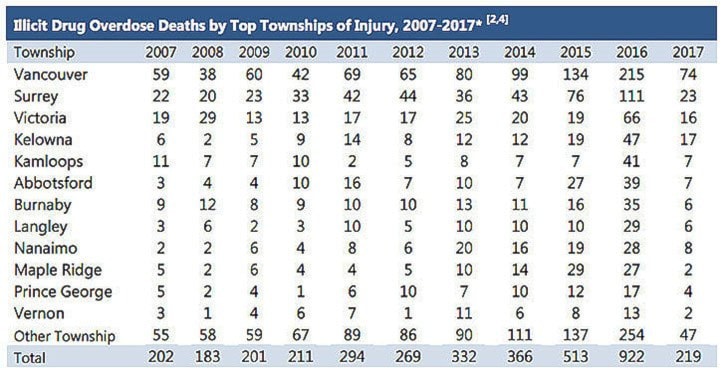Two drug overdose deaths were recorded in Kamloops in February 2017, down from five in January of this year. This reflects a trend downwards province-wide, which saw 102 overdose deaths in February, down slightly from 112 in January.
However, the February number reflects a 72.9 per cent increase in overdose deaths compared to the same month last year. In 2016 a record 922 people lost their lives due to the use of illicit drugs. The 2017 numbers show more than seven people dying of overdoses every two days.
Males accounted for 83.1 per cent of the deaths, and those in the 30 to 39 and 40 to 49 age groups accounted for the largest number of overall deaths.
Chief coroner Lisa Lapointe said 89 per cent of illicit drug overdose deaths in February occurred inside (the majority were in private residences). There were no deaths reported at any of the province’s safe injection or overdose prevention sites. There are two overdose prevention sites in Kamloops.
“This is evidence that these sites are saving lives,” Lapointe said. “People need to be encouraged to visit these sites, as the majority of deaths are occurring when people use illicit substances without medical attention or assistance nearby.”
In April 2016, the number of drug overdose deaths prompted provincial health officer Dr. Perry Kendall to declare the issue a public health emergency.
Since then, the provincial government has taken several measures to try to deal with the crisis, including providing approximately $13 million to help ease the financial pressures that are being put on health authorities as they deal with drug overdoses; creating more than 20 overdose prevention sites around the province; and, as of March 5, 2017, distributing 32,858 naloxone kits at no charge to at-risk people and those close to them.
The take-home naloxone kits are available at 476 locations around the province, including emergency departments, corrections facilities, and First Nations sites serving 96 communities. Some 5,500 naloxone kits have been distributed so far this year.
“While I’m very relieved to see that the numbers have not continued to increase over the last two months, we are still losing cherished members of our communities at a terrible rate,” Lapointe said. “People are dying in far higher numbers than we’ve ever seen, and a slight decrease in fatalities from the previous month should not be seen as any indication that the risk has decreased.”
